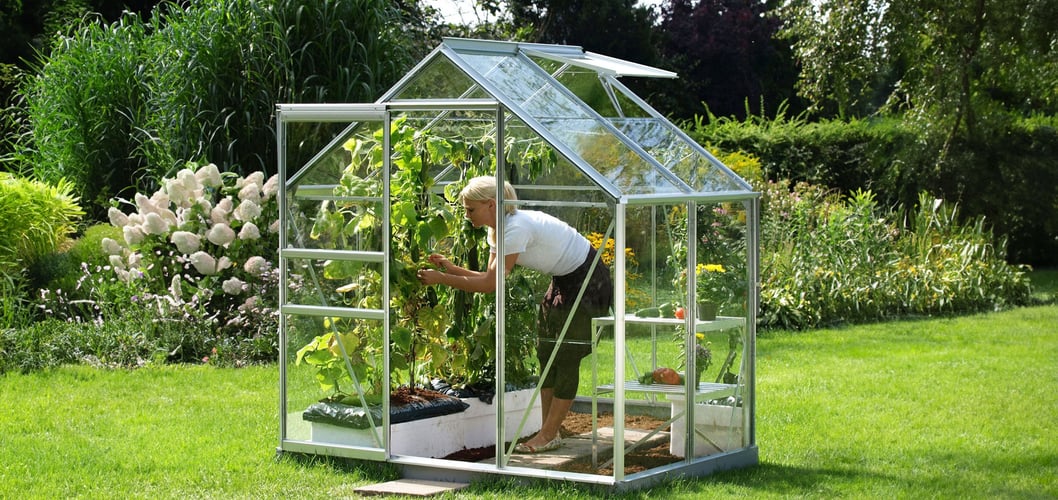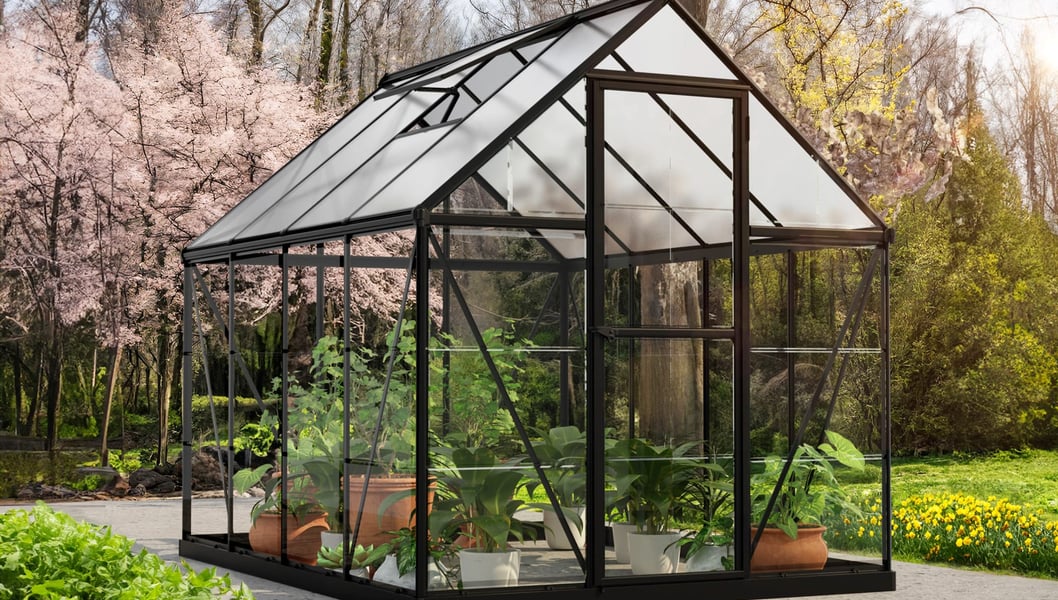How does a Greenhouse work?
Written by Matt W on 1st Nov 2024.
How Greenhouses Work?
Key Takeaways
- Trapping Sunlight: Greenhouses trap sunlight and convert it into warmth, creating a microclimate suitable for year-round growing.
- Managing Environment: Managing temperature, humidity, and air circulation is crucial for optimal growing conditions.
- Ventilation: Ventilation is essential for temperature control, and a combination of roof vents and side openings is recommended.
- Material Impact: Different materials store and release heat at varying rates, which can be used to manage temperature.
- Extending Growing Season: Greenhouses can extend the growing season, allowing for the cultivation of various plants throughout the year.
What is a greenhouse?
A greenhouse serves as a protected growing space with walls and roof built from transparent materials such as glass or polycarbonate panels. These structures create an optimal growing climate by trapping heat and light—acting like nature's incubator for your plants.
From commercial farmers managing acres of crops to home gardeners tending to tomatoes and herbs, greenhouses offer a controlled environment that shields plants from harsh weather, extends growing seasons, and boosts plant growth.
The magic of a greenhouse lies in its ability to maintain steady temperatures and humidity levels, letting you grow your favorite fruits, vegetables, and flowers throughout the year—even when outdoor conditions would make it impossible.

How do greenhouses work?
Greenhouses function as natural heat traps, using a simple yet brilliant scientific principle. The transparent walls and roof allow sunlight to stream in freely, warming the air, plants, and soil inside. While light passes through easily, the heat it generates becomes trapped—creating a cozy microclimate for your plants.
The magic happens when materials inside the greenhouse—soil, water, and even the plants themselves—absorb this solar energy and slowly release it back as heat. Soil rich in iron acts as a natural heat bank, soaking up warmth during sunny periods and gradually releasing it when temperatures drop, keeping conditions stable throughout day and night cycles.
Without outside winds to whisk away this precious heat, the enclosed space maintains a consistently warmer temperature than the world outside. This creates an ideal growing environment that shields your plants from cold snaps and harsh weather while providing all the sunshine they need for healthy growth.
This balanced, protected setting is why greenhouse growers can nurture thriving plants even when outdoor conditions would make growing impossible—giving you the power to extend seasons and grow varieties that might otherwise struggle in your local climate.
A Greenhouse's Daily Dance with Temperature
Understanding how greenhouses work means following their daily rhythm. As dawn breaks, the first rays begin their work of warming the space. By midday, you might find me adjusting vents and doors in a carefully choreographed routine to maintain the perfect balance of warmth and fresh air. This ventilation isn't just about comfort - it's a crucial part of how greenhouses work to create optimal growing conditions.

Through years of tending my greenhouse, I've learned that success lies in working with these natural patterns rather than against them. The structure doesn't just trap heat; it creates its own ecosystem, where temperature, humidity, and air circulation dance together in perfect harmony. Each season brings its own rhythm - spring's gentle warming calls for different care than summer's intense heat or winter's biting cold. Understanding these patterns has taught me that a greenhouse is less a building and more a living system that responds to every change in light, temperature, and moisture.
Mastering the Greenhouse Effect in Your Garden
The greenhouse effect in our garden sanctuaries mirrors nature's own warming process, though on a more intimate scale. I've discovered that the key to understanding how greenhouses work lies in observing this process: watching how the morning sun warms the soil in my raised beds, feeling the changing humidity as the day progresses, and learning to read the subtle signs that tell me when to intervene with ventilation or additional insulation.
This natural warming process is fascinating to observe. As morning light streams through the glass, it transforms into infrared radiation upon hitting surfaces inside - the soil, plants, and structural elements. While this infrared energy would normally escape back into the atmosphere, the greenhouse's glass or polycarbonate panels create a barrier, trapping this heat energy inside. It's like watching nature perform a magic trick, but one grounded in scientific principles that we can harness for our benefit.
The real mastery comes in managing this process. I've found that different materials store and release heat at varying rates - dark-colored surfaces absorb more heat, while light ones reflect it. Water-filled containers along the north wall act as heat batteries, slowly charging during the day and releasing warmth through the night. Even the color of your plant pots can make a difference - black pots near heat-loving plants can create micro-zones of warmth.
What are greenhouses used for?
Greenhouses give you the upper hand against unpredictable British weather. With our notoriously fickle climate—brief summers and lengthy, cold winters—a greenhouse creates a reliable growing environment when outdoor conditions simply won't cooperate.
By setting up a greenhouse, you can stretch your growing calendar significantly. Start sowing seeds weeks earlier than usual, and keep plants like French beans and cucumbers producing long after outdoor plants have stopped. Your protected plants continue thriving while their outdoor counterparts struggle against autumn chills.
The warm sanctuary of a greenhouse opens possibilities for growing plants that typically can't handle British weather. Exotic varieties such as melons and sweet potatoes that would normally fail in our climate can flourish in the consistent warmth.
Perhaps most valuable during harsh winters, a greenhouse safeguards your sensitive plants from killing frosts. Those special specimens that would perish during December freezes can survive comfortably behind glass, ready to thrive again when spring arrives.
Year-Round Growing: The Heart of Greenhouse Magic
One of the most remarkable aspects of how greenhouses work is their ability to extend our growing season. In my greenhouse, spring begins in February, while winter vegetables flourish well into December. This isn't just about temperature - it's about creating a protected environment where plants can thrive regardless of the weather beyond the glass. I've successfully grown tomatoes until November and started sweet peas in January, pushing the boundaries of traditional growing seasons.
For those determined to nurture life through the coldest months, understanding how greenhouses work becomes even more crucial. We create layers of protection - bubble wrap catching the light while trapping warmth, thermal screens drawing a protective veil at nightfall. These aren't just techniques; they're part of the greenhouse's vital story. I've developed a winter routine that includes:
- Adding a layer of bubble wrap insulation in late autumn, carefully sealed around the edges to prevent heat escape
- Installing thermal blinds that can be drawn at sunset to create an extra insulating air gap
- Using horticultural fleece as an additional layer around sensitive plants
- Positioning thermal mass elements strategically - water-filled containers painted black to absorb maximum heat
- Creating microclimates within the greenhouse using varying heights and protective screens
Advanced Temperature Management in Your Greenhouse
Temperature control is both vital, and difficult, without the right ventilation in place. Over the years, I've come to understand that basics, like having a louvre vent in the greenhouse, and automatic roof vent openers make the job of keeping humidity at bay simple. It starts with understanding your greenhouse's unique characteristics - its orientation, glazing material, and natural airflow patterns. I monitor temperatures at different heights and locations within the greenhouse, as variations can be significant. Near the roof, temperatures might be 5-10°C warmer than at ground level.
| Temperature (°C) | Suitable Plants | Growing Notes | Seasonal Tips |
|---|---|---|---|
| 10 | Lettuce, Spinach, Kale, Swiss Chard | Perfect for winter salad gardens | Ideal autumn/winter crops; protect from frost with fleece |
| 15 | Carrots, Peas, Brassicas, Spring Onions | Early spring prosperity | Great for early season starts; maintain good air circulation |
| 20 | Tomatoes, Peppers, Aubergines | Mediterranean warmth | Monitor humidity; morning watering recommended |
| 25 | Cucumbers, Melons, Squash | Summer abundance | Shade during peak summer; regular feeding essential |
| 30 | Pepper, Basil, Globe Artichokes | Tropical paradise | Careful ventilation needed; mist for humidity |
Ready to begin your own greenhouse journey? Explore our range of greenhouses here. For deeper insights, our Greenhouse Buyers Guide offers wisdom gained from generations of greenhouse gardening.
Different types of greenhouse
Gardeners have multiple greenhouse options to match their specific space and needs. For those with ample garden space, a full-sized freestanding greenhouse offers maximum growing area and versatility for year-round cultivation.
Space-limited? Consider a lean to greenhouse that attaches directly to your house wall. These space-efficient structures provide the same quality growing environment while using just half the footprint of traditional models, plus they benefit from the heat radiating from your home.
For patio gardens, balconies or allotments, mini greenhouses offer practical growing space without requiring significant room. These compact structures can often be moved as needed, giving you flexibility throughout the seasons.
When even mini greenhouses won't fit, aluminium cold frames provide protected growing space in the smallest packages. Perfect for hardening off seedlings or extending your growing season, these low-profile options can sit directly on the ground or on raised beds to give your plants just enough protection from harsh elements.
Frequently Asked Questions About Greenhouse Management
How do greenhouses stay warm at night?
In my experience, a greenhouse's warmth at night comes from the day's stored heat in thermal mass - think water barrels, stone paths, and soil beds. These elements slowly release their warmth through the evening, like a hot water bottle keeping your plants cosy. For maximum efficiency, I position black water barrels along the north wall where they catch the most sun during the day. On particularly cold nights, I've found that adding horticultural fleece or thermal blinds provides that extra layer of protection. A max-min thermometer helps track overnight temperatures, allowing you to adjust your heating and ventilation strategy accordingly.
What's the best way to ventilate a greenhouse?
Ventilation is down to having enough roof vents and louvre vents for the size of greenhouse you have. The key is creating a natural flow of air using a combination of roof vents and side openings. I open the roof vents first thing in the morning, adjusting them throughout the day based on temperature and humidity. It's like conducting an orchestra - every adjustment influences the greenhouse's microclimate. For optimal ventilation, I follow a systematic approach:
- Early morning: Open roof vents slightly to prevent humidity buildup
- Mid-morning: Increase ventilation as temperatures rise
- Afternoon: Monitor and adjust based on temperature and wind conditions
- Evening: Reduce ventilation gradually to retain some warmth for night
How do you prevent a greenhouse from overheating?
Preventing overheating is one of the most practical aspects of understanding how greenhouses work. In my greenhouse, I use a combination of shade netting, automatic vent openers, and common sense timing for watering. The key is to act preventatively - once a greenhouse overheats, it can take hours to bring the temperature back down to optimal levels. My comprehensive approach includes:
- Installing shade netting before the height of summer
- Using automated vent openers that respond to temperature changes
- Creating humidity by damping down paths in hot weather
- Strategic placement of heat-sensitive plants away from the most intense sun
- Regular monitoring with accurate thermometers at different heights
Remember, successful greenhouse gardening is about creating and maintaining the perfect environment for your plants to thrive. It's a rewarding journey that combines science, observation, and a touch of horticultural artistry.